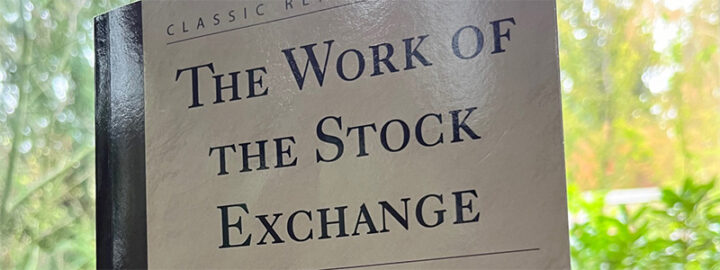
Despite the fact that stock markets have been operating for over 400 years, how exactly they work at the level of individual participate and individual role is rarely documented. Here in the 21st Century most of the accounts are how to make money as an investor, two or three steps away from the actual transactions taking place within the exchange.
Which is why it was so fascinating to find and read The Work of the Stock Exchange by James Edward Meeker, published in 1922, long out of print, but currently being re-printed and available on Amazon by Forgotten Books.
This book explains the inner workings of The New York Stock Exchange as of the early 1920s, one hundred years ago. An age with ubiquitous telephones and stock tickers. With brokers processing orders from across the continent and overseas on the emerging prominence of the NYSE, one of 50 or so American stock exchanges, down from 150 a few decades prior.
Most importantly, this book walks through the whole process of an order being placed, from the slip of paper that was the order form to the open cry at the matching post, to the nightly clearing house, the daily money markets, the margin calls, the short sales, and the seats around the country at brokerage houses where account holders could sit and watch the prices update, manually copied from the ticker tape. Plus the $2 brokers, odd-lot brokers, and specialists all assisting the floor brokers in getting those orders filled.
Here in the 21st Century, four generations removed from these processes, it is hard to fathom how millions of shares were traded daily with no more technology than a telephone, pneumatic tube, mechanical adding machine, and tons and tons of paper slips, often in triplicate thanks to carbon paper. How many people reading this blog have ever touched a piece of carbon paper?
Personally, given my proclivity to systems design, what fascinated me the most were five interlocking systems. 1) posts, 2) the open outcry auction, 3) the specialists, 4) the odd-lot brokers, 5) the clearinghouse, and 6) the daily money market, 7) continuous trading.
Posts – The NYSE moved into its current building in 1902. The trading floor is a very large room with a very high ceiling, held up by large posts. According to this book, each post was marked with 12 company names, with the trading for that company in a sector around that one post. With a chalkboard for each company showing the symbol, last closing price, today’s opening price, and latest price. It makes total logical sense for trading to be in the same place for each company, but something about that being around a post seems like an idea from ancient Rome.
Open Outcry – When I was a teenager in the 1980s, I used to watch Wall Street Week on PBS and they’d often have short snippets of video showing the floor of the NYSE and the traders trading. I still find it amazing that dozens of people in a loud, crowded space was considered an efficient way to match buyers and sellers. This book didn’t talk about hand signals. Perhaps they came later. This book says “Take it” was the key phrase one brokers would yell to another to make a match. And this book said NYSE staff would be standing at the post listening to these orders to note the latest price and get it posted on the ticker, rather than waiting for the order slips to get handed in.
Specialists / Market Makers – Amazingly, no one knows who was the first specialist nor when that role become common on the NYSE. The apocryphal story in this book is that a broker with a broken leg brought a chair on the floor, set it up at one post and just traded shares in that one company all day. Other brokers came to him to facilitate their trades for that company, and the role of specialist was born.
Fast forward 100 years and market makers are still a key participant in the NYSE. Today they operate the Open and Closing auctions each day. In 1922 they were just another voice in the outcry, but generally theirs was the first call on the Open, as they had a book of orders to fill, not just one or two orders at a time.
Odd-lot Brokers – Long long ago it was decided that stocks would trade in 100 share blocks. This held true to the end of the 20th Century, except that it was possible to trade in smaller increments, where 1-99 shares were known as “odd lots”. To implement these trades, the brokers turned to another special role on the floor, the “odd lot brokers”. They bought and sold 100 share blocks to make this possible, holding the differences themselves. They generally charged just 1/8th per dollar per share extra for this service.
Which BTW, if you didn’t know, the stock exchanges in America all traded in prices based on 1/8th dollar increments, not 1/100ths. The NYSE didn’t decimalize until January 29, 2001!
Clearinghouse – In 1901 it was possible for 100 shares of US Steel to be purchased through the Adams brokerage, then sold the Baker brokerage, then those shares resold to Charles & Co, then to Delany Partners, and on to Ely & Sons, all of this within a single day. To settle those five trades, after hours Adams would have to send the paper stock certificate to Baker, who would have to send the paper certificate to Charles, then finally Delany delivering it to Ely. And each hand-over with a matching bank draft too. That became untenable as the daily volumes increased.
The fix was a clearinghouse, which each night calculated the net movement of all the shares and all the cash, resulting in reports that told Adams to deliver the paper shares to Ely, despite Adams and Ely never meeting during trading hours. And that report requiring Ely to pay Adams and possibly Charles and Delany too for each of their profits, or possibly Charles owing Ely money due to some other trades from the same day. Clearinghouses, in general, are still used today. However, doing that work in software seems trivial while doing this work with paper forms and adding machines seems bordering on magical.
Money Market – Let’s say that 100 shares of US Steel sold for $85 per share. Adams owed someone $8,500 for that first purchase. Baker owed Adams about the same. Etc. Adams probably sold some shares that same day, but wouldn’t get paid for them until tomorrow. So where did Adams turn to borrow money for a day to cover the amount due? Not the banks. That would be too slow.
Instead, the NYSE had a money market on the floor of the exchange that specialized in daily loans. Loans backed by NYSE stocks and bonds. A standardized system for members to lend to each other, with paper envelopes filled with stock and bond certificates as collateral. With yet-another pool of men with adding machines to determine the value of the securities in those envelopes, as the general rule was that the loans would automatically renew each day unless one side or another called it done.
Continuous Trading – Most surprisingly, and the way I found this book, was one paragraph early in the book explaining how the NYSE switched over to continuous trading after the Civil War. Probably in 1872. Before that each stock was “called” for its turn to trade.
This is one of those assumptions I love to uncover. I thought stock exchanges had always been continuous. No apocryphal story of the trading in Amsterdam, London, or the Button Wood tree on Wall Street in New York City ever mentioned a specific time of day for trading a specific stock.
But in hindsight this system makes total sense, as there just were not enough trades per day until the late 1800s for any given company, and thus the better systems design is to concentrate those orders to a specific time of day, just as stock exchanges concentrate orders to a single place.
This book is 700 pages, so of course I’m just skimming the surface in this blog post. If you are anything like me and like to understand how complex systems like the NSYE work, and especially how they worked before those systems were replaced with software, I highly recommend this book.













